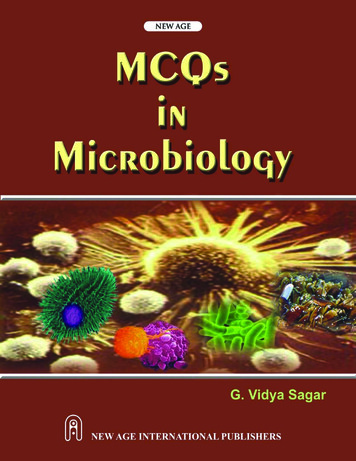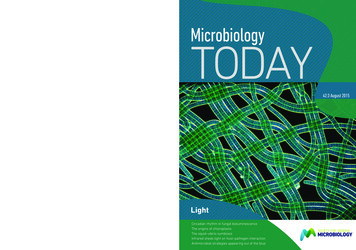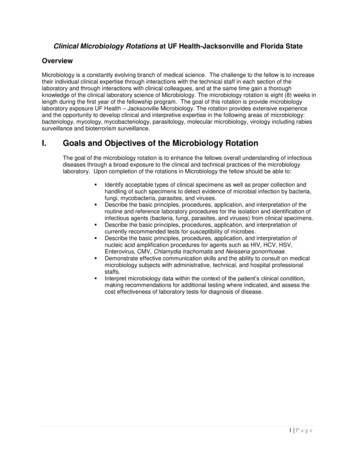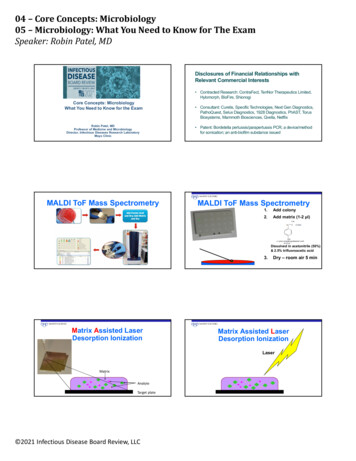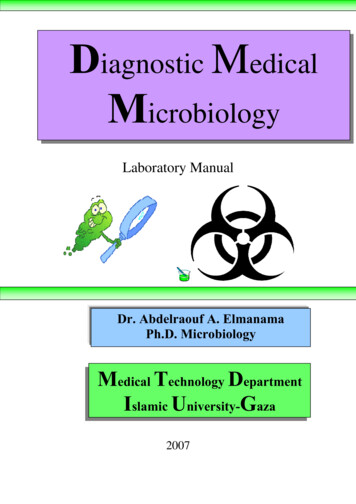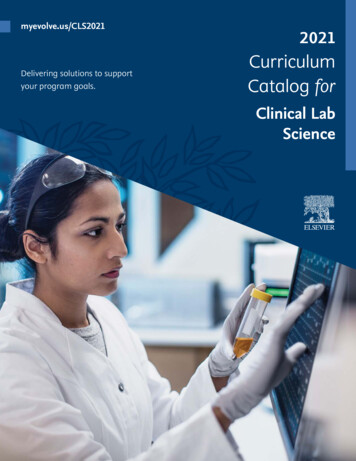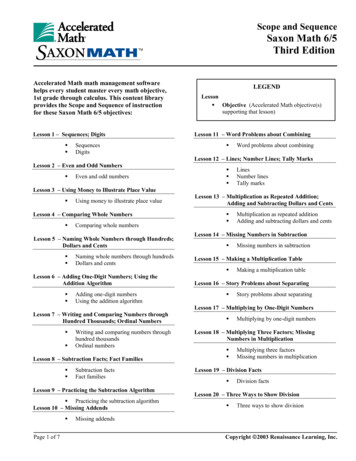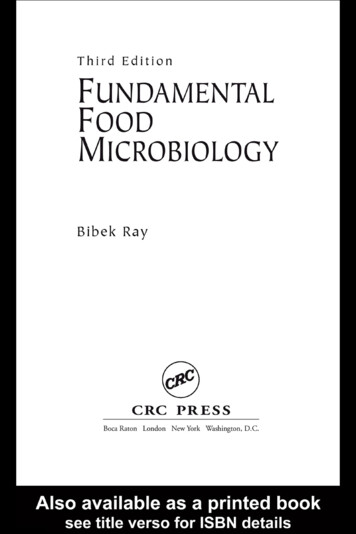
Transcription
Third EditionFUNDAMENTALFOODMICROBIOLOGYBibek RayCRC PR E S SBoca Raton London New York Washington, D.C.
This edition published in the Taylor & Francis e-Library, 2005.“To purchase your own copy of this or any of Taylor & Francis or Routledge’scollection of thousands of eBooks please go to www.eBookstore.tandf.co.uk.”Cover Image:Microscope with easy phase contrast, dark field, and bright light facilities (M 4002 D).(Courtesy of Swift Instrument International, S.A.)Library of Congress Cataloging-in-Publication DataRay, BibekFundamental food microbiology / Bibek Ray. --3rd ed.p. cm.Includes bibliographical references and index.ISBN 0-8493-1610-31. Food--Microbiology. I. TitleQR115.R39 2003664d.001d579--dc222003055738This book contains information obtained from authentic and highly regarded sources. Reprinted materialis quoted with permission, and sources are indicated. A wide variety of references are listed. Reasonableefforts have been made to publish reliable data and information, but the author and the publisher cannotassume responsibility for the validity of all materials or for the consequences of their use.Neither this book nor any part may be reproduced or transmitted in any form or by any means, electronicor mechanical, including photocopying, microfilming, and recording, or by any information storage orretrieval system, without prior permission in writing from the publisher.The consent of CRC Press LLC does not extend to copying for general distribution, for promotion, forcreating new works, or for resale. Specific permission must be obtained in writing from CRC Press LLCfor such copying.Direct all inquiries to CRC Press LLC, 2000 N.W. Corporate Blvd., Boca Raton, Florida 33431.Trademark Notice: Product or corporate names may be trademarks or registered trademarks, and areused only for identification and explanation, without intent to infringe.Visit the CRC Press Web site at www.crcpress.com 2004 by CRC Press LLCNo claim to original U.S. Government worksInternational Standard Book Number 0-8493-1610-3Library of Congress Card Number 2003055738ISBN 0-203-99825-1 Master e-book ISBN
DedicationTo my parents, Hem and Kiron, and my family
Preface to the Third EditionIn the third edition, substantial changes have been made in most of the chapters andin their logical arrangement. In addition, one new chapter has been added. Thechapter on microbial stress has been written to include various manifestations ofbacteria under stress and their importance in food microbiology. As before, this bookis written primarily for students taking undergraduate food microbiology courses.However, it can be used as a reference in other related courses in many disciplinesas well as by professionals engaged directly and indirectly in food-related areas. Ithank Elizabeth Smith for her excellent typing and editing in the preparation of themanuscript. Finally, I thank my students for their helpful suggestions, especially forthe new materials included in this edition.
Preface to the First EditionBetween the time I first studied food microbiology as an undergraduate student andnow, the discipline has undergone a radical change. This change is well expressedby Dr. David Mossel of the Netherlands in his letter published in ASM News (59,493, 1993): from “no challenge in plate count and coliform scouting” to “linkageof molecular biology to food safety (also food bioprocessing and food stability)strategies — proclaim a new era in food microbiology.” This transition was necessaryto meet the changes that occurred in the food industry, especially in the U.S. andother developed countries. The necessary knowledge, techniques, and expertise forthis transition were available. This book reflects this transition from the traditionalapproach to an approach to meet the needs of those who are directly or indirectlyinterested in food microbiology.Introductory food microbiology is a required course for undergraduates majoringin food science. In some form it is also taught in several other programs, such asmicrobiology, public health, nutrition and dietetics, and veterinary science. For themajority of food scientists, except those majoring in food microbiology, this singlecourse forms the basis of the study of microorganisms and their interactions to food.Similarly, for the latter group, food microbiology is probably the only course thatprovides information on the interaction of food and microorganisms. This book waswritten with the major objective of relating interaction of microorganisms and foodin relation to food bioprocessing, food spoilage, and foodborne diseases. Thus, itwill be useful as a text in the introductory food microbiology courses taught undervarious programs and disciplines. In addition, it will be a valuable reference forthose directly and indirectly involved in food and microbiology, including individualsin academic institutions; research institutions; federal, state, and local governmentagencies; food industries; food consultants; and even food lobbyists.The subject matter is divided into seven sections. For undergraduate teaching,the first six sections can be taught as a semester course; Section VII (Appendices)can be used as advanced information for an undergraduate course which containsmaterials that are either taught in other courses, such as advanced food microbiology,or food safety courses and laboratory courses. Section I describes the history of foodmicrobiology, characteristics of microorganisms important in foods, their sources,and significance. Section II deals with microbial growth and metabolism of food,and the significance of microbial sublethal injury and bacterial sporulation in foods.Section III explains the different beneficial uses of microorganisms, which includestarter cultures, bioprocessing, biopreservation, and probiotics. Section IV deals withspoilage of foods by microorganisms and their enzymes and methods used to determine food spoilage. In addition, there is a chapter on problems and solutions ofsome emerging spoilage bacteria in refrigerated foods. Section V deals with foodborne pathogens associated with intoxication, infections, and toxicoinfections andthose considered to be opportunistic pathogens, as well as pathogenic parasites andalgae. In addition, a chapter has been included on emerging pathogens and a chapteron indicators of pathogens. Section VI discusses different methods used to controlundesirable microorganisms for the safety and stability of food. A chapter on new
nonthermal methods and a chapter on the hurdle concept in food preservation areincluded.The materials in each chapter are arranged in logical, systematic, and concisesequences. Tables, figures, and data have been used only when they are necessaryfor better understanding. At the end of each chapter, a limited list of selectedreferences and suggested questions have been included. To reduce confusion, especially for those not familiar with the constant changes in microbial genera, threefirst letters have been used to identify the genus of a species. The index has beenprepared carefully so that the materials in the text can be easily found.I thank Mrs. Deb Rogers for her excellent performance in typing the manuscript.Finally, I thank my students, who, over a period of the last 20 years, have suggestedwhat they would like to have in a food microbiology course. Their suggestions havebeen followed while writing this text.
Preface to the Second EditionIt is gratifying to find that CRC Press showed interest in a second edition within 3years of the initial publication of Fundamental Food Microbiology. As indicatedpreviously, this book was written primarily as a text for undergraduate food microbiology courses. The main objective was to provide basic and applied informationin as many areas as possible in about 500 pages. In the second edition, the materialswere carefully edited and new information included to keep it up to date. As before,the second edition will be important not only to undergraduate students in a foodmicrobiology course, but also as a valuable reference book to graduate students inthe food science area, to individuals associated with the science, application, production, and regulation of foods as related to microorganisms in academic institutions, research institutions, and food-testing laboratories. In addition, short courseorganizers, food consultants, food industries, food regulatory agencies, and foodscience professionals will find this book valuable to understand and solve problemsassociated with microbiological aspects of food. I thank Mrs. Deb Rogers for herexcellent typing and editing in the preparation of the manuscript and the studentsin the food microbiology class for their helpful suggestions, including the newmaterial in the second edition.
The AuthorBibek Ray, Ph.D., was a professor of food microbiology in the Department ofAnimal Science at the University of Wyoming, Laramie. Professor Ray earned B.S.and M.S. degrees in veterinary science from the University of Calcutta and Universityof Madras, in India, respectively. He received his Ph.D. in food science from theUniversity of Minnesota in 1970 and joined the faculty in the Department of FoodScience, North Carolina State University, and then the Department of Biology atShaw University, both at Raleigh. He joined the University of Wyoming in 1981.There he expanded his research to intestinal beneficial bacteria, bacteriocins ofGram-positive bacteria, and high hydrostatic pressure preservation of food alongwith his previous research activities in the area of microbial sublethal injury. Healso taught courses in food microbiology, food fermentation, food safety, and acourse titled “Safety of Our Food” to nonscience undergraduates. His laboratorywas involved in extensive and thorough studies in both basic and applied areas ofthe bacteriocin pediocin AcH from Pediococcus acidilactici H. In addition, his groupstudied various aspects of bacteriocins produced by Lactococcus, Leuconostoc,Lactobacillus, and Pediococcus as well as Bacillus and Staphylococcus spp. Hereceived research funding from the National Science Foundation, American PublicHealth Association, National Live Stock and Meat Board, United States Departmentof Agriculture, United States Army Research, North Atlantic Treaty Organization(with Turkey) and Binational Agriculture Research Development Agency (withIsrael), Wyoming Development Fund, and the industry. Before retirement, he wasstudying the combined effect of bacteriocins, ultrahigh hydrostatic pressure, andpulse field electricity and sublethal injury on the destruction of microbial cells andspores and its application in food preservation. In addition, Dr. Ray establishedcollaborative research programs with research institutes and universities in Turkey,Israel, India, Indonesia, and France.Professor Ray has published more than 100 research articles, reviews, bookchapters, proceedings articles, and popular articles on food microbiology. He has alsoedited four books: Injured Index and Pathogenic Bacteria (1989) and Food Biopreservatives of Microbial Origin (1992, with Dr. M.A. Daeschel), both published by CRCPress, Boca Raton, Florida; Lactic Acid Bacteria: Current Advances in Metabolism,Genetics, and Applications (1996, with Dr. Faruk Bozoglu), Springer, New York; andNovel Processing and Control Technologies in the Food Industry (1999, with Dr.Faruk Bozoglu and Tibor Deak), IOS Press, Washington, D.C. He was a member ofthe American Society for Microbiology and the Institute of Food Technologists anda Fellow of the American Academy of Microbiology. He also served on the editorialboards of the Journal of Food Protection, Applied and Environmental Microbiology,and the Indian Journal of Microbiology. In 1994, Professor Ray was awarded theUniversity of Wyoming Presidential Achievement Award in recognition of his excellence in academic performance. He retired from the University of Wyoming inSeptember 2002. He is presently involved in developing a center to improve health,education, and economic conditions of underprivileged people in his village of birthin India and spends a great deal of his time in the village.
Table of ContentsSection IIntroduction to Microbes in Foods . 1Chapter 1History and Development of Food Microbiology .3Chapter 2Characteristics of Predominant Microorganisms in Food .13Chapter 3Sources of Microorganisms in Foods .35Chapter 4Normal Microbiological Quality of Foods and its Significance . 43Section IIMicrobial Growth Response in the Food Environment. 55Chapter 5Microbial Growth Characteristics .57Chapter 6Factors Influencing Microbial Growth in Food .67Chapter 7Microbial Metabolism of Food Components .81Chapter 8Microbial Sporulation and Germination .93Chapter 9Microbial Stress Response in the Food Environment .103Section IIIBeneficial Uses of Microorganisms in Food . 123Chapter 10Microorganisms Used in Food Fermentation .125
Chapter 11Biochemistry of Some Beneficial Traits .137Chapter 12Genetics of Some Beneficial Traits .151Chapter 13Starter Cultures and Bacteriophages .173Chapter 14Microbiology of Fermented Food Production .183Chapter 15Intestinal Beneficial Bacteria .209Chapter 16Food Biopreservatives of Microbial Origin .225Chapter 17Food Ingredients and Enzymes of Microbial Origin .243Section IVMicrobial Food Spoilage . 255Chapter 18Important Factors in Microbial Food Spoilage .257Chapter 19Spoilage of Specific Food Groups .269Chapter 20New Food Spoilage Bacteria in Refrigerated Foods .289Chapter 21Food Spoilage by Microbial Enzymes . 305Chapter 22Indicators of Microbial Food Spoilage .313Section VMicrobial Foodborne Diseases . 321
Chapter 23Important Facts in Foodborne Diseases . 323Chapter 24Foodborne Intoxications .343Chapter 25Foodborne Infections .359Chapter 26Foodborne Toxicoinfections .391Chapter 27Opportunistic Pathogens, Parasites, and Algal Toxins .405Chapter 28New and Emerging Foodborne Pathogens .417Chapter 29Indicators of Bacterial Pathogens .429Section VIControl of Microorganisms in Foods . 439Chapter 30Control of Access (Cleaning and Sanitation) .441Chapter 31Control by Physical Removal .451Chapter 32Control by Heat .455Chapter 33Control by Low Temperature . 467Chapter 34Control by Reduced Aw .475Chapter 35Control by Low pH and Organic Acids .483Chapter 36Control by Modified Atmosphere (or Reducing O–R Potential) .491
Chapter 37Control by Antimicrobial Preservatives .497Chapter 38Control by Irradiation .507Chapter 39Control by Novel Processing Technologies . 515Chapter 40Control by a Combination of Methods (Hurdle Concept) .529Section VIIAppendices . 535Appendix AMicrobial Attachment to Food and Equipment Surfaces .537Appendix BPredictive Modeling of Microbial Growth in Food .541Appendix CRegulatory Agencies Monitoring Microbiological Safety of Foodsin the U.S. .545Appendix DHazard Analysis Critical Control Points (HACCP) .549Appendix EDetection of Microorganisms in Food and Food Environment .555Index.567
SECTION IIntroduction to Microbes in FoodsMicroorganisms are living entities of microscopic size and include bacteria, viruses,yeasts and molds (together designated as fungi), algae, and protozoa. For a longtime, bacteria have been classified as procaryotes (cells without definite nuclei), andthe fungi, algae, and protozoa as eucaryotes (cells with nuclei); viruses do not haveregular cell structures and are classified separately. In the 1990s this classificationchanged, and will be briefly mentioned in Chapter 2. Microorganisms are presenteverywhere on Earth, including humans, animals, plants and other living creatures,soil, water, and atmosphere, and they can multiply everywhere except in the atmosphere. Together, their numbers far exceed all other living cells on this planet. Theywere the first living cells to inhabit the Earth more than 3 billion years ago and sincethen have played important roles, many of which are beneficial to other livingsystems.Among the microorganisms, some molds, yeasts, bacteria, and viruses have bothdesirable and undesirable roles in our food. In this section, importance of microorganisms in food, predominant microorganisms associated with food, sources fromwhich they get in the food, and microbiological quality of food under normalconditions are presented in the following ry and Development of Food MicrobiologyCharacteristics of Predominant Microorganisms in FoodSources of Microorganisms in FoodNormal Microbiological Quality of Foods and Its Significance
CHAPTER 1History and Development of ion .3Discovery of Microorganisms .3Where Are They Coming From? .4What Are Their Functions? .5Development of Early Food Microbiology (Before 1900 A.D.) .5Food Microbiology: Current Status .8A. Food Fermentation/Probiotics .8B. Food Spoilage .8C. Foodborne Diseases .8D. Miscellaneous .9VII. Food Microbiology and Food Microbiologists .9VIII. Conclusion .10References. 10Questions. 11I. INTRODUCTIONExcept for a few sterile foods, all foods harbor one or more types of microorganisms.Some of them have desirable roles in food, such as in the production of naturallyfermented food, whereas others cause food spoilage and foodborne diseases. Tostudy the role of microorganisms in food and to control them when necessary, it isimportant to isolate them in pure culture and study their morphological, physiological, biochemical, and genetic characteristics. Some of the simplest techniques inuse today for these studies were developed over the last 300 years; a brief descriptionis included here.3
4FUNDAMENTAL FOOD MICROBIOLOGYII. DISCOVERY OF MICROORGANISMSThe discovery of microorganisms1–3 ran parallel with the invention and improvementof the microscope. Around 1658, Athanasius Kircher reported that, using a microscope, he had seen minute living worms in putrid meat and milk. The magnificationpower of his microscope was so low that he could not have seen bacteria. In 1664,Robert Hooke described the structure of molds. However, probably the first personto see different types of microorganisms, especially bacteria, under a microscopethat probably did not have a magnification power above 300v, was Antony vanLeeuwenhoek. He observed bacteria in saliva, rainwater, vinegar, and other materials;sketched the three morphological groups (spheroids or cocci, cylindrical rods orbacilli, and spiral or spirilla); and also described some to be motile. He called themanimalcules, and between 1676 and 1683 he reported his observations to the newlyformed leading scientific organization, The Royal Society of London, where hisobservations were read with fascination. As reasonably good microscopes were noteasily available at the time, other interested individuals and scientists during thenext 100 years only confirmed Leeuwenhoek's observations. In the 19th century, asan outcome of the Industrial Revolution, improved microscopes became more easilyavailable, which stimulated many inquisitive minds to observe and describe thecreatures they discovered under a microscope. By 1838, Ehrenberg (who introducedthe term bacteria) had proposed at least 16 species in four genera and by 1875Ferdinand Cohn had developed the preliminary classification system of bacteria.Cohn also was the first to discover that some bacteria produced spores. Although,like bacteria, the existence of submicroscopic viruses was recognized in the mid19th century, they were observed only after the invention of the electron microscopein the 1940s.III. WHERE ARE THEY COMING FROM?Following Leeuwenhoek's discovery, although there were no bursts of activity, somescientific minds were curious to determine from where the animalcules, observedto be present in many different objects, were emanating.1–3 Society had just emergedfrom the Renaissance period, and science, known as experimental philosophy, wasin its infancy. The theory of spontaneous generation, i.e., the generation of someform of life from nonliving objects, had many powerful followers among the educated and elite classes. Since the time of the Greeks, the emergence of maggotsfrom dead bodies and spoiled flesh was thought to be due to spontaneous generation.However, ca. 1665, Redi disproved that theory by showing that the maggots inspoiled meat and fish could only appear if flies were allowed to contaminate them.The advocates of the spontaneous generation theory argued that the animalculescould not regenerate by themselves (biogenesis), but they were present in differentthings only through abiogenesis (spontaneous generation). In 1749, TurbevillNeedham showed that boiled meat and meat broth, following storage in coveredflasks, could have the presence of animalcules within a short time. This was usedto prove the appearance of these animalcules by spontaneous generation. Lazzaro
HISTORY AND DEVELOPMENT OF FOOD MICROBIOLOGY5Spallanzani (1765) showed that boiling the meat infusion in broth in a flask andsealing the flask immediately prevented the appearance of these microscopic organisms, thereby disproving Needham's theory.This was the time when Antoine Laurent Lavoisier and his coworkers showedthe need of oxygen for life. The believers of abiogenesis rejected Spallanzani'sobservation, suggesting that there was not enough vital force (oxygen) present inthe sealed flask for animalcules to appear through spontaneous generation. Later,Schulze (1830, by passing air through acid), Theodore Schwann (1838, by passingair through red-hot tubes), and Schröeder (1854, by passing air through cotton)showed that bacteria failed to appear in boiled meat infusion even in the presenceof air. Finally, in 1861, Louis Pasteur demonstrated that, in boiled infusion, bacteriacould grow only if the infusions were contaminated with bacteria carried by dustparticles in air.1,4 His careful and controlled studies proved that bacteria were ableto reproduce (biogenesis) and life could not originate by spontaneous generation.John Tyndall, in 1870, showed that boiled infusion could be stored in dust-free airin a box without microbial growth.IV. WHAT ARE THEIR FUNCTIONS?The involvement of invisible organisms in many diseases in humans was suspectedas early as the 13th century by Roger Bacon. In the 16th century, Girolamo Fracastoro of Verona suggested that many human diseases were transmitted from personto person by small creatures. This was also indicated by Kircher in 1658. In 1762,von Plenciz of Vienna suggested that different invisible organisms were responsiblefor different diseases. Theodore Schwann (1837) and Hermann Helmholtz (1843)proposed that putrefaction and fermentation were connected with the presence ofthe organisms derived from air. Finally, Pasteur, in 1875, showed that wine fermentation from grapes and souring of wine were caused by microorganisms. He alsoproved that spoilage of meat and milk was associated with the growth of microorganisms. Later, he showed the association of microorganisms with several diseasesin humans, cattle, and sheep, and he also developed vaccines against a few humanand animal diseases caused by microorganisms, including rabies. Robert Koch, inGermany (in the 1880s and 1890s), isolated pure cultures of bacteria responsiblefor anthrax, cholera, and tuberculosis. He also developed the famous Koch's postulates to associate a specific bacterium as a causative agent for a specific disease.Along with his associates, he also developed techniques of agar plating methods toisolate bacteria in pure cultures and to determine microbial numbers in a sample,the Petri dish (by Petri in his laboratory), staining methods for better microscopicobservation of bacteria, and the use of steam to sterilize materials to grow bacteria.1,5With time, the importance of microorganisms in human and animal diseases,soil fertility, plant diseases, fermentation, food spoilage and foodborne diseases, andother areas was recognized, and microbiology was developed as a specific discipline.Later, it was divided into several subdisciplines, such as medical microbiology, soilmicrobiology, plant pathology, and food microbiology.\
6FUNDAMENTAL FOOD MICROBIOLOGYV. DEVELOPMENT OF EARLY FOOD MICROBIOLOGY(BEFORE 1900 A.D.)It is logical to comprehend that our early Homo ancestors, the hunters and gatherers,were aware of food spoilage and foodborne diseases. Even without any perceptionof the causative agents, they used ice and fire to preserve foods and make them safe.Around 8000 B.C., as agriculture and animal husbandry were adopted by the earlycivilizations, food supply, especially agricultural produce, became available in abundance during the growing seasons. Preservation of foods became important foruniform supply of food around the year. Between 8000 and 1000 B.C., many foodpreservation methods such as drying, cooking, baking, smoking, salting, sugaring(with honey), low-temperature storage (in ice), storage without air (in pits), fermentation (with fruits, grains, and milk), pickling, and spicing were used, probablymainly to reduce spoilage. However, one cannot be sure whether the society at thattime recognized the implications of diseases transmitted through food. In the laterperiods, however, the scriptural injunctions laid by many religions suggest that thesocieties recognized an association of diseases with some foods. Some of the regulations, such as not eating meat from a diseased animal or an animal killed by ascavenger, or not eating a food that appeared unnatural or had been handled by anunclean person, were developed to safeguard the health of citizens against foodbornediseases. Fermentation was used extensively by many societies not only to preservefoods but also as a method to produce various types
This book reflects this transition from the traditional . majoring in food science. In some form it is also taught in several other programs, such as microbiology, public health, nutrition and dietetics, and veterinary science. For the majority of food scientists, except those majoring in food microbiol


